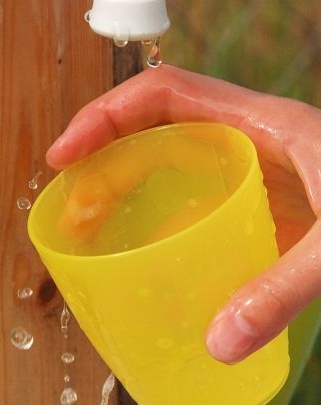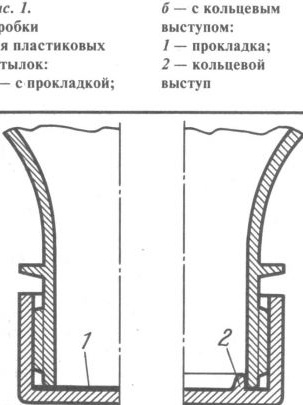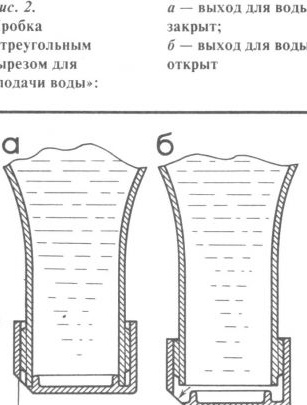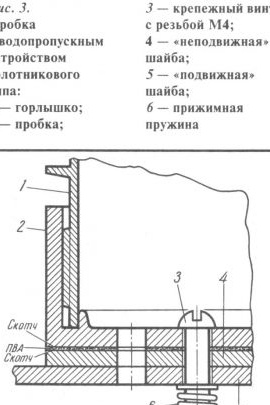Why just do not use plastic bottles from under soft drinks. About the transformation of such plastic bottles into vases, cup holders and various floating toys, we wrote in previous articles. And now we’ll talk about fulfilling the responsibilities of a regular country washstand with a plastic bottle.
The first idea to adapt a plastic bottle for such purposes turned out to be quite simple: the bottom of the bottle was cut off, hung upside down with its closed neck and pierced with a nail. They took out the nail - the water poured, put the nail back in - the water stopped flowing. Everything would be fine, and most importantly - simple. But uncomfortable! Take out the nail, put the nail in, and it rusts. I had to admit that with this combination of device simplicity and consumer qualities, the idea did not justify itself.
Inquisitive heads came up with another solution, known by the program “So far, everyone is at home” - to provide water for washing hands on cottages by device directly in the cork of the bottle triangular cutout. Turning the plug a small angle opened the water outlet, turning back the water supply stopped. The solution is original, simple and reliable enough, considering that the service life of such a country washstand is limited to a maximum of one summer season.
But is it possible to come up with some other solution to this problem?
It turns out you can. But first, a little more about the cork-caps of plastic bottles.
The fact is that these plastic plugs come with two types of seals. In fig. 1, a plug is shown that seals a bottle by pressing a thin polymer gasket to the neck. And at the cork draw. 1b, the seal with the neck of a plastic bottle is achieved without the use of a gasket, but with the help of an annular protrusion entering the neck of the bottle. (The figure does not show some details of the construction of the neck of a plastic bottle, on which there is also a special protrusion for centering the stopper when wrapping it on the thread.) Of course, the option of a stopper with an annular protrusion is more reliable and durable when the bottle-stopper kit is reusable. And it is clear that the option of a bottle cottage wash-hand basin with a triangular slot in the lid (Fig. 2) is only possible in the case of a cork with an annular ledge. A triangular slot is made at the place of transition of the bottom of the plug into a cylindrical surface so that a through channel forms in the inner cavity of the plastic plug, but so that its annular protrusion is not damaged.
When the stopper is tightly screwed onto the neck thread, the water outlet is closed, as there is no gap between the surface of the annular protrusion and the neck of the bottle. But unscrew the plug a little, then the tightness of the joint of the plug-neck is broken and water begins to flow out through the triangular cut. The direction of the trickle of water here is not vertical, but along the radius, which is even more convenient. It is easy to attach a lead-handle to the cork for greater convenience of controlling this “valve”, which will even give the construction a certain technical completeness. It is not recommended to use a plug with a gasket for the “tap”, since it quickly starts to leak.
The idea of turning a bottle into a summer wash-hand basin, related to the installation of a spool device on a plastic bottle cork (Fig. 3), reminiscent of a water tap with a water outlet made of two ceramic washers pressed against each other, is quite interesting.
As can be seen from the figure, a “fixed” washer made of organic glass is glued to the surface of the cork, and a “movable” washer is pressed to this washer using a fixing screw and spring. In the bottom of the plastic plug and in both washers, a hole was drilled for the passage of water. Since the lower washer can rotate around the fixing screw, when the through hole in the bottom of the plug coincides with the washer glued to it with the hole in the movable washer, water from the bottle starts to leak out. Turning the "movable" washer in any direction overlaps the channel for the exit of water.
Unfortunately, the simplicity of this design does not correspond to the simplicity of its manufacture. The difficulties are as follows. The fact is that it is not so easy to stick something to the bottom of the cork from a plastic bottle. This is usually done like this. A layer of adhesive tape - adhesive tape with good "adhesive ability" is glued onto the connected surfaces of the bottom of the cork and the "fixed" washer. And only after that the cork and the washer are glued together, and more precisely, their surfaces covered with adhesive tape, tightening the parts with a screw until the glue completely dries (PVA).
A thread (preferably an incomplete profile) is cut into the hole drilled in the glued bottom of the plug and washer for the fixing screw. Note that water will not go through the thread because of its incomplete profile and as a result of thread smearing with the same PVA glue. As you can see, PVA glue in this case plays the role of not only glue, but sealant.
The "movable" washer rotates freely on the mounting screw, but for a denser joining of the surfaces of both washers, it is advisable to use a spring or spring washer (see Fig. 3).
Washers can be made from any sheet of plastic, such as vinyl plastic or polystyrene, but organic glass is more preferable because of its considerable hardness. It is advisable to lightly rub the friction surfaces of the washers with a waterproof grease, such as Lithol. And further. Do this spool device only on a cork with an annular protrusion, since with a cork with a stable gasket it is very easy to render it unusable, after which the plastic cork ceases to “compact”.
The cut bottom of a plastic bottle is suitable as a lid of a country washstand, as well as a soap dish. To fix a home-made washstand on the wall, pick up another same plastic bottle, cut off the bottom and neck of the bottle, and form a cutout in the side surface. As a result, get a case for hanging a country washstand. The case is mounted on a wooden wall screws with washers.




